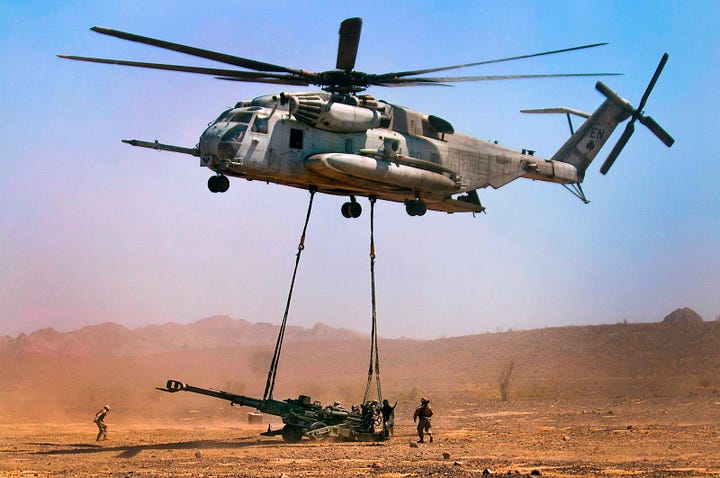A Thought Experiment on Taiwan: The Consequences of Peace
Let’s play a thought experiment. Suppose that over the next two or three decades, China continues to develop the sort of capabilities that could be used in a Taiwan scenario—all types of aircraft, amphibs, containerized missiles, sealift, etc. Let’s also suppose that Taiwan undertakes a serious armament program to repel an invasion, aided by the United States and perhaps Japan and Australia. Finally, let’s imagine that, for whatever reason, an invasion never takes place. How does that affect militaries around the world? How does the development of weapon systems designed for a specific situation shape operational capabilities more broadly?
Three years of major war in Europe have finally shifted discussion from abstractions and general operational concepts to the base layer of equipment that enables warfighting. Nowadays we hear blessedly little about OODA loops or maneuvers against centers of gravity, and much more about force structures and specific operating environments. It is also widely acknowledged how much contemporary militaries’ force design is shaped by the legacy of their Cold War-era armaments.
What is less well acknowledged is the degree to which those Cold War armaments were designed for a very specific operational problem. It was not generic great power competition that drove weapons development in the Warsaw Pact and in NATO, but the particular geography of the North European Plain. One side attempted to solve its problem with mass quantities of armor that could break through to the Atlantic, protected by mobile air defenses integrated into small formations; the other looked to combinations of infantry, armor, and airpower that could delay and destroy those onrushing columns. Although a multitude of other capabilities were built into this general scheme and have been added since, this remains the fundamental operating concept embedded in most large militaries today.
A corollary is that Cold War concepts of operation shape present-day employment of force. The Ukraine War is an obvious case; an even more paradigmatic example is Operation Desert Storm. Differences in terrain, correlation of forces, operational capability, and objectives notwithstanding, the Gulf War was a clear demonstration of NATO concepts against a Soviet-armed adversary.
An Amphibious Baseline
Which raises questions for the present day. If China and the US are indeed embarking on a multi-decade armaments contest around the Taiwan Strait, the weapons they develop will proliferate far outside the region. Both countries will make arms sales to friendly third parties to defray costs and lock in alliances. They will also cast off older systems as technology progresses, driving proliferation beyond their close allies. The net result is that militaries around the world will acquire many substantially new capabilities.
An obvious first-order effect is that any country with an extensive coastline will be more vulnerable to amphibious assault. Much has been made of the amphibious barges China has developed to land equipment on inhospitable beaches, first reported by the Western press in January and first seen this month. Presumably intended to sustain forces ashore before port facilities can be seized/repaired, these would be even more effective in countries that lack such infrastructure to begin with. A desolate coastline could be a positive advantage to an attacker that can establish a base ashore, using it to project force inland.
Nor must an amphibious assault necessarily use surface vessels. I’ve speculated elsewhere about the prospects of air-mechanized assault in the 21st century. If MLRSs are developed that are light enough to be sling-loaded by helicopter, they could be delivered from amphibious ships to establish on-shore firebases—useful in a Taiwan scenario or in lower-intensity operations elsewhere.


The possibilities extend beyond amphibious assaults. The combination of containerized launch platforms and USVs could be useful even when no other naval forces are involved—used in support of a ground invasion, they could stretch a country’s anti-missile defenses. In Ukraine, for instance, anti-ship missiles would be far less of a deterrent against USVs firing cruise missiles.

Finally, there are plenty of imaginable uses for these sorts of weapons outside a ship-to-shore scenario. UUVs and USVs could leverage the types of sensor nets being developed in the Western Pacific to enforce blockades or interrupt shipping over great distances—perhaps we even see piracy from afar as the open ocean becomes a chokepoint.
The Mid-21st Century and Beyond
These are only some possible consequences of current developments, and highly speculative ones at that. It is anyone’s guess what new technologies will come along in the meantime which could completely upend all existing assumptions, or what political developments could make the entire question moot.
Yet the broader point remains. History is full of weapons and techniques devised for a specific problem, which then proliferated widely. The hoplite phalanx was arguably a solution to the particular social and economic dynamics in feuding Greek poleis, but won great success farther afield. The rapid advances of 17th-century siege techniques century was driven by the military geography and politics of the border between France and the Spanish Netherlands, but was widely adopted across Europe. The Cold War standoff in central Europe is only the latest; it is worth considering what the next will be.
Thank you for reading the Bazaar of War. Most articles are free for all to read, but a subscription option is available to all who wish to support. Subscribers receive a pdf of the critical edition of the classic The Art of War in Italy: 1494-1529, and will have exclusive access to occasional pieces.
You can also support by purchasing Saladin the Strategist in paperback or Kindle format.




There’s something unsettling about the idea that peace can be just as strategically draining as war. Both sides getting stuck in a cycle of preparation without ever pulling the trigger.